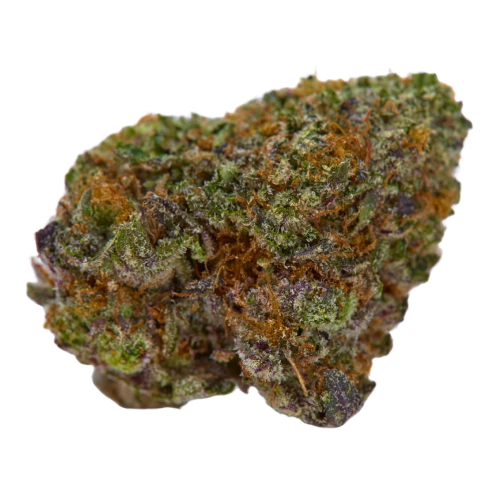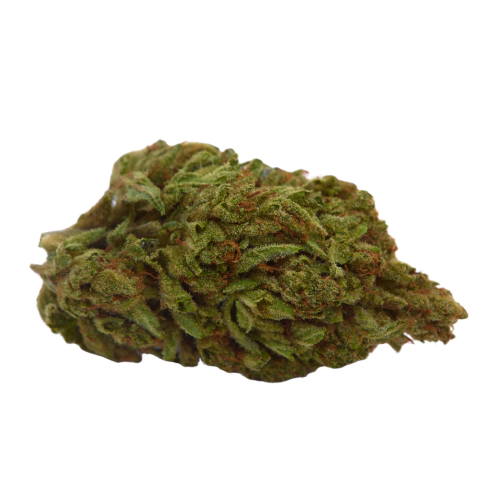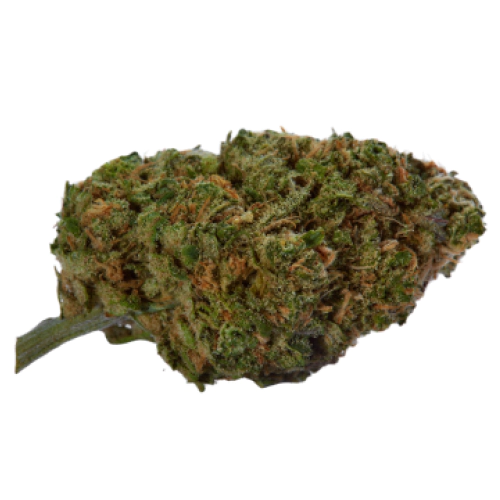THC 15 - 18%
CBD 0.21 - 0.43%
Effect Uplifted
Flavor Honey
19.11 - 23.33%
0.32 - 0.63%
0.15 - 0.68%
Spicyherbal, Chemical
Hungry
Cross two strains that taste as good as Black Cherry Soda and Huckleberry Hound, and the outcome couldn’t get better than Huckleberry Soda. Distinguished by its signature, tart-sweet berry flavor, this strain offers a nice mix of enjoyment options, making it welcome for both early morning and off-hour consumption. Whereas, the weed’s THC concentration measured at 19.11-23.33% and a CBD level of 0.32-0.63% make it suitable for both light smokers and experienced consumers looking to experience an intense body high. Other cannabinoids occurring in Huckleberry Soda weed strain are as follows:
What sets this weed apart is its color. As is common with most Indica-dominant strains, it has vibrant purple-colored buds with orange and light olive accents that grow densely packed on thick, flexible stems.
Another highlight of Huckleberry Soda strain is, without a doubt, its taste. Reminiscent of cherry soda and cotton candy, it will caress any smoker’s taste buds with its flavorful hit, virtually filling the mouth with sweet fruity notes brought by a combo of terpineol and myrcene. The presence of limonene is given off with a chemical tint and spiciness on the exhale, giving zest to the flavor profile.
After smoking this cannabis, most users describe their state as fully relaxed and uplifted, with a touch of creativity jolt. At the same time, due to its genes, this strain also has sedative effects that can leave some users a bit numb and slightly disoriented and induce them to cut off from the outside world. Another common effect caused by Huckleberry Soda strain is hunger. Due to this, it is often recommended for people with appetite loss. Besides that, this weed can be used by MMJ diagnosed with:
Even though the effects of Huckleberry Soda are quite soft and mild, smoking in high doses may cause side effects in sensitive people, causing:
Cultivating this cannabis is quite easy and requires no special skills or knowledge. Just like all Indica-dominant varieties, it can be grown both indoors and outdoors and has an average flowering cycle varying from 51 to 59 days. Grown indoors, the plant yields about 0.5-1 Oz, whereas outdoor harvests can reach up to 10-15 Oz, which is equivalent to 400 g of dried flowers. It is also remarkable that the cannabis perfectly adapts to various soil conditions and grows quite compact, reaching from 30” up to 60” in height.
| THC | Tetrahydrocannabinol, or THC, is a major cannabis chemical compound. It is a psychoactive element that stimulates dopamine release and induces euphoria or happiness. THC-rich strains may be helpful with such conditions as lack of appetite, chronic pains , etc. It is considered to be the primary active marijuana component. | 19.11 - 23.33% |
| CBD | Cannabidiol, or CBD, is a major compound in cannabis, which is non-psychoactive. It is also proved to counteract the side effects of the second major component THC. CBD is widely used for medicinal purposes in rubs, oils and so on. It is helpful in muscle pain cases, may treat arthritis and migraines. Even Greeks used it against pain, while Queen Victoria applied it to get rid of menstrual cramps. | 0.32 - 0.63% |
| CBC | Cannabichromene, or CBC, is a minor cannabinoid, meaning that its quantity in cannabis is quite little. Though it has the same origin as CBD and THC, it is different in functions. Without any psychoactive effects, it is an efficient cannabis compound in combating acne and depression. CBC produces analgesic, antibacterial and anti-inflammatory effects. | 0.12 - 0.4% |
| CBG | Cannabigerol, or CBG, is one of the minor cannabis compounds in adult plants. On the other hand, young ones contain a lot of this antibacterial and anti-inflammatory component. During the growth, CBG is converted into different cannabinoids, mostly THC and CBD. The compound itself increases appetite and decreases eye pressure. | 0.15 - 0.68% |
| CBN | Cannabinol, or CBN, is a trace element in cannabis that is considered to be mildly psychoactive. It appears from oxidation THC, exposed to light and heat. CBN is mostly contained in old cannabis and in traditional hashish. It is effective against insomnia, bacterial infections and appetite loss. | 0.32 - 0.29% |
| THCV | Tetrahydrocannabivarin, or THC-V, is a compound contained in cannabis in trace amounts. Even though it is close to THC molecularly, it is different in effects. This compound may be psychoactive only in large amounts. THC-V reduces blood sugar, controls appetite, stimulates bone growth, etc. African Sativa strains are the richest in THC-V. | 0.22 - 0.48% |
| Pinene | Pinene is one of the most widespread terpenes in nature, found in pine trees, basil, nutmeg, parsley, and rosemary. Cannabis containing terpene (alpha-pinene or α-pinene) boasts a strong pine scent. Pinene is responsible for anti-inflammatory, pain-relieving, and anti-anxiety effects. | 0.07% |
| Myrcene | Myrcene (also known as β-myrcene) is one of the most common terpenes found in cannabis, representing more than 20% of the modern marijuana terpene profile. Myrcene has a distinct earthy, musky flavor, resembling cloves. It is responsible for calming and soothing effects of weed. Myrcene is also found in hops, thyme, mango, lemongrass, guava melon. | 0.23% |
| Humulene | Humulene (also known as α-humulene) is one of the major terpenes found in cannabis, contributing to woody, earthy, spicy, herbaceous, and, mainly, floral aromas of cannabis. Used in modern medicine, humulene offers anti-inflammatory, antibacterial, and appetite suppressant effects, which have been well-researched by pharmaceutical companies. | 0.05% |
| Limonene | Limonene (also known as d-limonene) is the second most common terpene in nature and the third most common terpene in cannabis. It has a powerful citrus aroma and can be found in all citruses, including lemons, oranges, grapefruits, limes, juniper, etc. Limonene is known to elevate moods and provide anxiety, depression, and stress relief. | 0.15% |
| Linalool | Linalool (also known as beta linalool, linalyl alcohol, linaloyl oxide, and p-linalool) is one of the rarest terpenes found in cannabis, mostly in small quantities. Linalool is known for its spicy and lavender aroma, bringing relaxation and calming effects. It is also said to provide anti-inflammatory and analgesic properties that can be useful for athletes. | 0.08% |
| Sabinene | Sabinene is a terpene with a peppery, spicy, citrusy, and piney aroma, presented in Norway spruce, Holm oak trees, black pepper, cardamom, and carrot seeds. Found in cannabis in small quantities. Allegedly, sabinene has anti-inflammatory and antimicrobial properties. | 0.14% |
| Terpineol | Terpineol (also known as alpha-terpineol or a-terpineol) is a terpene naturally occurring in more than 150 plants, including lilacs, lime blossoms, eucalyptus sap, and pines. Among the therapeutic qualities are anti-inflammatory, antioxidant, antitumor, and antimicrobial. In cannabis, terpineol boasts the distinctive pine smoke aroma and causes a relaxing, sedative effect. | 0.18% |
| Terpinolene | Terpinolene is one of the most common terpenes found in cannabis; however, It's usually presented in small quantities. Is responsible for piney, floral, herbaceous, and even a little bit citrusy aroma of cannabis. Terpinolene can be found in lilacs, nutmeg, and cumin. In cannabis, terpinolene contributes to the sensation of "freshness." Has the potential to reduce the risk of heart diseases. | 0.01% |
| Caryophyllene | Caryophyllene (also known as beta or b caryophyllene) is a terpene found in many herbs and spices, such as black pepper, basil, rosemary, and oregano. Cannabis high in caryophyllene delivers a strong spicy, peppery aroma, resembling cinnamon and cloves. Caryophyllene offers potent anti-inflammatory and sedative effects. | 0.1% |
| Total terpenes content | 1.01% |
THC 15 - 18%
CBD 0.21 - 0.43%
Effect Uplifted
Flavor Honey
THC 18 - 23%
CBD 0.05 - 0.41%
Effect Uplifted
Flavor Grapefruit
THC 13 - 19%
CBD 0.08 - 1.03%
Effect Creative
Flavor Chemical
THC 20.25 - 22.75%
CBD 0.62 - 0.83%
Effect Sleepy
Flavor Spicyherbal

THC 18.5 - 20.25%
CBD 0.52 - 0.7%
Effect Relaxed
Flavor Pungent
THC 17 - 19%
CBD 0.05 - 0.21%
Effect Tingly
Flavor Menthol
THC 17 - 19%
CBD 0.13 - 0.3%
Effect Giggly
Flavor Sweet

THC 20.5 - 23.5%
CBD 0.58 - 1.12%
Effect Relaxed
Flavor Peach
THC 11.83 - 16.33%
CBD 0.25 - 1.35%
Effect Euphoric
Flavor Skunk
THC 14 - 14%
CBD 0.17 - 0.43%
Effect Creative
Flavor Menthol
THC 22 - 24%
CBD 0.42 - 0.62%
Effect Sleepy
Flavor Pine
THC 19 - 23%
CBD 0.05 - 0.92%
Effect Euphoric
Flavor Violet
THC 20 - 21%
CBD 0.38 - 0.64%
Effect Focused
Flavor Flowery
THC 21 - 23%
CBD 1.09 - 1.39%
Effect Euphoric
Flavor Flowery
THC 19 - 23%
CBD 0.57 - 0.69%
Effect Energetic
Flavor Skunk

THC 13.58 - 17.5%
CBD 0.02 - 0.29%
Effect Happy
Flavor Honey
THC 17.5 - 25.5%
CBD 0.26 - 1.33%
Effect Talkative
Flavor Sweet

THC 17.5 - 19.75%
CBD 0.24 - 0.57%
Effect Sleepy
Flavor Flowery
THC 15 - 16%
CBD 1.12 - 1.24%
Effect Sleepy
Flavor Pineapple
THC 15 - 17%
CBD 0.48 - 0.64%
Effect Hungry
Flavor Lavender
Be the first and share your opinion
Write a Review